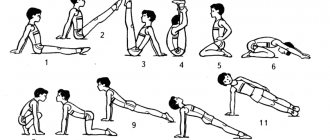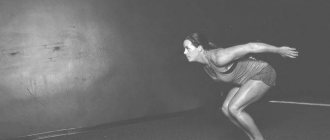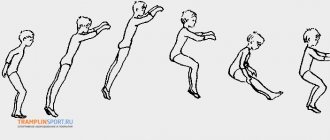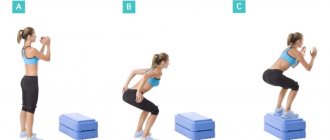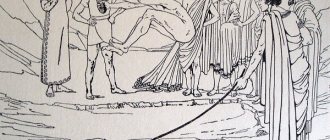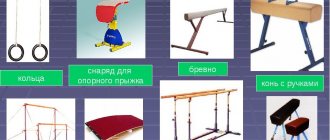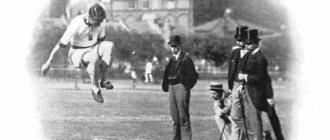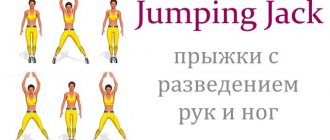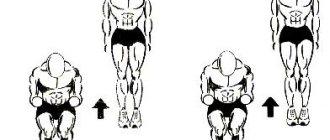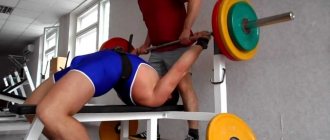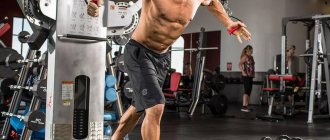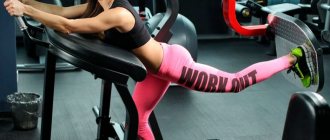Gymnastic jumps, affecting the human body, develop agility, muscle strength, speed and coordination of movements. They are accessible to almost everyone, regardless of age, gender and level of training.
The ability to easily jump is an indicator of the practitioner’s good preparation. They are also used in gymnastic performances of various levels, which adds entertainment and emotionality to the competition.
They are divided into two groups: simple (non-supported) and support jumps.
The first include those that are performed without supporting the hands on the projectile. These are high jumps or long jumps (from a standing or running start), deep jumps (from a gymnastic apparatus or from a suspended platform), from a springboard, as well as jumping rope.
Vault jumps are a type of exercise that consists of overcoming (from a running start) a specially designed obstacle in a certain way, using an intermediate support. In this case, it is gymnastic equipment. An example is a vault over a goat or horse. The projectile can be placed in length or width.
The vault can be performed straight or sideways.
Its technique has the following phases:
- Take-off run.
- Leap onto a gymnastic bridge.
- Foot push.
- Flight phase.
- Push with hands on the projectile.
- Flight after a hand push.
- Landing.
The gymnast's completion of each phase serves as a preparatory stage for the next. A mistake in performing any of the stages will ruin the entire vault over the goat. At the same time, the performance of jumps by men and women does not have any special differences in technique.
Takeoff run
The take-off run must be carried out with uniform acceleration, since fluctuations in its speed negatively affect the quality of the jump. The speed of good gymnasts reaches eight or more meters per second.
It must be started from one starting position, keeping the length constant. The speed when moving is increased gradually - a sharp start interferes with the smoothness of movements.
The length of the run-up distance depends on the type of apparatus, the type of jump itself, the degree of training of the gymnast and much more.
For beginners, this distance is usually about 10 meters. The step technique is the same as when running short distances.
Leap onto the bridge
It occurs at the moment of reaching the highest speed. Lowering it before jumping onto the bridge worsens the result of the jump and indicates incorrect technique.
When pouncing, the torso is slightly tilted forward, the bent pushing leg approaches the fly leg. Both of them are in front of the body. After which the straight connected legs are brought forward. When your feet touch the bridge, your hands are down.
The higher the take-off speed, the greater the distance between the projectile and the bridge. Usually this is half a meter or a meter.
Subsequent flight and hand push
In this phase, the gymnast makes a preliminary swing back with his legs, straightening his torso. It helps create conditions for rapid flexion of the body in the joints of the pelvis when pushing with the hands.
Taking off from the projectile is the most difficult moment that vaults contain. This is a whole complex of interconnected movements. Despite the short duration, the gymnast’s actions are strictly consistent.
There are three phases in a push:
- placing straight arms on a support;
- receiving a blow with bending the arms at the elbows and “sinking” at the shoulders, while the tension of the extensor muscles increases;
- the active push-off phase, during which the shoulder girdle quickly moves upward, the arms straighten at the elbows and bend at the wrists.
During any jump, support on the projectile occurs in front of the body. The push with the arms must be combined with a jerk with the torso, leading to an upward lift of the pelvis and braking of the legs. This increases the push-off efficiency by increasing the pressure on the support.
The push with the arms ends at the moment the shoulders cross the vertical line drawn through the line where they are positioned. This gives the maximum altitude for subsequent takeoff.
Benefit
When jumping, all muscles work, including the heart, so it is a good cardio exercise.
The heart muscle is trained during the run-up, which contributes to the correct execution of the jump. Jumping is included in the school physical education curriculum from the first grade, but middle and high school students jump over the goat. Of course, in artistic gymnastics everything is different - this apparatus of the compulsory gymnastics program begins to be studied from the age of five. Jumping requires strong-willed qualities that are developed in training:
- courage - not everyone dares to jump on a goat, much less jump over it;
- determination - after pushing off from the bridge, you need to decisively complete the exercise, otherwise a fall is inevitable, you can trip over a goat;
- agility - flying over a goat takes a split second, you need to fully control this fleeting process.
Ligaments, joints, muscles of the arms, legs, and body develop perfectly during the jump; the respiratory system also develops; the motor system is aimed at performing fast movements that require coherence of the whole organism.
Flight after propulsion phase and landing
The position of the athlete’s body in flight depends on the type of jump. The quality of this phase of the exercise affects the overall score. Having fixed the position required for a particular type of jump, the gymnast straightens up before landing.
Landing occurs on the toes of straightened, tense legs, and it is necessary to immediately lower yourself completely onto the foot and increase the pressure on the desired side so as not to lose balance, for which the athlete’s body is forced to make a wave-like movement. To soften the impact on the support, it is necessary to bend your legs elastically when landing. A hard landing usually leads to loss of balance and often injury.
There are different types of applied vaults.
Impact on the body
Like other gymnastics exercises, jumping over a support (horse or goat) comprehensively trains all the muscles of the body. In addition to large muscle groups, they affect small stabilizer muscles and develop joint flexibility. With the right approach, this exercise can become an important part of the training process.
Many trainers also consider jumping jacks as a cardio activity, as the run-up causes a sharp increase in heart rate. This has a positive effect on the body and tones the cardiovascular system.
Goat wide
The technique for performing a vault in this case consists of jumping onto the apparatus on your knees at point-blank range, then jumping off with your legs apart. It is required to jump onto your knees, with your arms pulled back, to lower yourself onto your heels and move your torso forward. With a strong swing of your arms, push off from the projectile, spread your legs and bend your body, perform a dismount.
Training stages:
- Sitting on your heels on the floor, kneel and wave your arms.
- Do the same and come into a squat, pushing off with your knees.
- From the “kneeling while standing” position, move to the “legs apart while standing” position.
- Go to the “spread legs” position with your arms raised.
If a student begins to fall, the coach needs to secure him under the chest or back.
Step-by-step technique
- You need to do different types of warm-up - walk on different parts of the foot, jog, squat, lunge, jump rope. Important muscles for jumping are warmed up by inclined and rotational movements of the body and pelvic joints. You can jump with your knees pressed to your chest.
- The run-up should be as fast as possible; to pick up the legs, it is better to run in short, quick steps. Since the run-up lasts about ten meters, you need to choose the optimal distance, depending on the type of projectile, the complexity of the jump and the level of knowledge of the exercise. Athletes, as a rule, mark the place of the run with chalk; they calculate this mark based on the size of their running steps in order to accurately get to the edge of the springy bridge.
- The pounce must be done at full speed, since braking will lead to a distortion of the jump technique, casting doubt on the possibility of its completion. When pushing off, the body leans slightly forward, legs together, hands down. Repulsion occurs through the springy action of the toes.
- Next comes the flight by swinging the legs back and straightening the torso towards the flight, the hands are placed on the goat, they take a fairly strong blow, and are pushed upward with the help of the shoulders. If the push is combined with an inert jerk of the body, then the pelvis rises, the legs stop and the athlete flies up.
- The judge's score mainly depends on the flight and subsequent landing. You need to land on your toes, but you need to immediately lower them and touch your heel to secure your feet on the mat, bending your knees, this will allow you to maintain balance. If you do not adhere to this technique, the load will be placed on the joints and injuries may occur.
Horse or goat wide
Jumping onto the apparatus is done in a squat, and the dismount is done in a bending position. Execution technique: push off with your feet, lean on the projectile with your hands. Jump on it and stop in a crouched position. Quickly straightening up, push off, simultaneously bending, spread your arms outward and upward. Land in the same position.
Training stages:
- Jump up on the floor from a crouching position with a soft landing.
- Practice a jump, achieving a stable landing, from a gymnastic bench, suspended platform or low beam.
- Leap onto the projectile, stopping in a crouched position, then jump off while bending over.
The insurance also includes support for the back or chest.
What is a gymnastic goat?
This jumping simulator is a leather-covered body on a steel support. The “legs” of the goat are metal stands, adjustable in height. The exercise machine is quite stable when installed even on an uneven floor. Most often found in two sizes. Dimensions of the small goat: 500*320*270 mm, large – 680*360*270 mm. Together with the legs, the height of the gymnastic goat is from 85 to 135 cm. The exercise machine can withstand a load of up to 100 kg.
To make a jump, you need to land and push off from the springy bridge. And it’s better to land on mats. Accordingly, their availability must also be taken care of in advance.
Jump over a horse with arms sideways
The technique of vaulting over such a horse has its own characteristics. Leaning on the horse's arms and pushing off with your feet, you should sharply move your bent body in the direction of the side of the jump. Moving your pelvis forward, bend over the apparatus, pushing with one hand and transferring the weight to the other. Being sideways over the horse, bend over, then push off with your supporting hand. Landing occurs with your back to the projectile.
Training stages:
- From the “lying support” position, use a foot push to move to the “lying side support” position on one of the hands (alternately right and left).
- Jump onto the horse sideways at point-blank range from the bridge.
- Grab the handles, push off the springboard with your feet and perform a side jump onto the horse.
- Do the same with a running start, holding the handle.
The coach must belay the student by holding him by the forearm and under the pelvis (standing at the landing site).
Phases of the jump
In gymnastics, there are several types of sports jumps. Jumps using a goat or horse are usually classified as support jumps. The gymnastic apparatus itself acts as a support.
The projectile can be installed in length or width. Depending on this, the jumping technique, in particular, the take-off distance, will vary. You can also choose one of the jumping styles - straight or lateral.
The standard technique of jumping over a horse has several stages:
- Run-up (the athlete accelerates before jumping onto the bridge).
- Leap onto the bridge (both feet must land on its springy surface).
- Pushing off with the legs (the elastic push from the bridge gives the body additional acceleration).
- Flight (in fact, this is the beginning of the jump until the moment it touches the support).
- Touching the surface of a horse or goat with your hands (repulsion from the projectile).
- Flight after the push (the final phase of the jump).
- Landing (ideally you want to land with both legs slightly bent and then straighten up).
At first glance, this sequence may seem very complicated. In reality, all stages pass very quickly and smoothly flow into one another. It is important to understand that all phases of the jump are equally important. If inaccuracy is made during any of them, it will ruin the entire exercise. Jumping over a gymnastic apparatus (horse or goat) practically does not differ in technique for men and women.
Vaults require preliminary preparation in the form of active warm-up and warming up of muscles and joints. Failure to comply with this rule can cause injury and severe muscle pain.
Long jump over a horse at an angle
The technique for performing a vault in this case is as follows. Push off with your left foot from the bridge, which is located on the side, and immediately lean on the horse with your right hand. At the same time, the swing leg moves up, the pushing leg follows it. The support goes sequentially on the right, both, and left hands. It must be maintained until landing.
The gymnast's body is bent when performing. The bridge is parallel to the horse. Landing occurs sideways to the sports equipment.
Training stages:
- While sitting on a horse, lean your arms behind your body and swing your legs, then jump off the apparatus and stand with your left side towards it.
- Sitting on a horse with your legs apart and leaning behind you on the horse with your hands, with a swing of your legs, jump off at an angle on both sides alternately.
- Jump off low bars at an angle from a seat on your hip with the help of a trainer, then on your own.
- Pounce at an angle onto the horse from a distance of a couple of steps into a sitting position.
- Practice jumping at an angle with support, then on your own.
The insurance also includes support for the shoulder and under the back.
Vault
Vaults are included in men's and women's gymnastics all-around as one of the independent types. These are short-term movements that are difficult to coordinate and require a lot of
concentration of muscle effort, spatial orientation, attention, determination and courage. They are performed with a running start, as a rule, by pushing both legs against the gymnastic bridge, with the obligatory intermediate support of the hands on the apparatus.
Vaults are included in the school curriculum from grades IV to XI. It includes the simplest jumps over a gymnastic goat and horse.
There are a huge number of varieties of vaults. About a hundred of them are performed at competitions of various ranks. The tendency to complicate exercises in all-around gymnastics is especially noticeable in vaults. Their complete acrobatization occurs. The same jump can become more complicated and modified depending on the place of support on the projectile, the inclusion of flips, turns, somersaults before and after pushing with the hands, etc. In addition, further development of vaults is possible with the improvement of jumping equipment and all equipment related to this type of gymnastic all-around (bridge, runway, landing mats, etc.).
Vaults are performed through various gymnastic apparatus, mainly through a goat and a horse, installed in width and length. In addition, they can be performed through “non-standard” gymnastic equipment, for example, through a stack of mats, a gymnastic beam, a gymnastic table, a gymnastic bench, a horse with handles, and through combined apparatus. Jumps over combined apparatus are complications of conventional jumps performed over gymnastic apparatus installed in various combinations. These unusual combinations of projectiles require students to be resourceful, oriented, and able to use their existing skills in unusual conditions. The use of this kind of projectiles and jumps brings great variety to the lesson. The height of the projectiles may vary.
A wide variety of vaults allows them to be used as a means of comprehensive influence on athletes of different gender, age and physical fitness. And the skills and abilities to perform them acquire great practical significance.
Vaults are divided into three groups:
1. straight jumps,
which are characterized by moving the body over the supporting area of the projectile without turning over the head. This group includes jumping legs apart, bent over, etc.
2. flip jumps,
in which the gymnast passes over the apparatus through a handstand, turning over his head in a bent, arched or tucked position. This includes forward flip jumps, forward bending jumps,
stretching-unbending, turning over followed by a forward somersault, etc. All jumps can be performed by pushing against the near or far part of the projectile without turning and with turns of 180° or more.
3. Side jumps,
during which the GCM of the gymnast’s body passes away from the support area. These include jumping sideways, at an angle, and bending over. They are performed through a goat, a horse in width, through a horse with handles, through combined apparatus.
Despite the wide variety of jumps, each of them has many elements that are similar in execution. They form the basis of the execution technique. To make it easier to learn the basics of jumping technique, each of them is conventionally divided into the following phases: run-up, jump onto the bridge, push with the legs, flight before the push with the hands, push with the hands, flight after the push with the hands and landing. Incorrect execution of at least one of the listed phases negatively affects the quality of the jump as a whole.
Takeoff run
plays an important role during subsequent phases of the jump. For highly qualified athletes, the take-off speed reaches 7.6 - 8.2 m/s. It increases with increasing skill. The time the gymnast spends in the flight phases depends on the speed of the takeoff and the strength of the push from the support. The length of the run-up for beginner gymnasts usually does not exceed 8 - 12 m, and for gymnasts of the highest ranks - 25 m. To perform the run-up correctly, it is necessary to start it from the same distance from the apparatus and the gymnast’s initial position at the start, and increase the speed gradually, since a sharp start causes stiffness of movements. When placing the leg on the support, it should not bend too much at the knee and ankle joints, otherwise there may be excessive stress on the working muscles. The push-off ends with full extension of the supporting leg at the knee and extreme flexion at the ankle joint. Running accuracy is of great importance. In order to calculate it, you need to know the length and number of running steps. With the correct take-off run, their length gradually increases; the last one, before hitting the bridge, is usually somewhat shorter than the previous one.
Leap onto the bridge and push off
are performed at the moment the gymnast acquires the greatest horizontal speed with a push of the strongest leg. The pushing leg, bent at the hip and knee joints, is pulled towards the swing leg, then the legs are connected and almost straight are carried forward, thereby providing a “stopping” jump onto the bridge. The length of the last Step is 2.3 - 2.8 m, and the flight path depends on the qualifications of the athlete and the form of the jump being performed. When pouncing, the torso leans forward (5 - 25° from the vertical), the legs are slightly ahead of it, the arms are below, so that they can make an active upward swing while pushing off from the bridge. Feet
at the place of repulsion, they are placed parallel to one another at the width of the foot. The time to jump onto the bridge usually ranges from 0.27-0.33 s.
Push-off is carried out through active extension of the legs at the knee, hip joints and plantar flexion of the feet. The feet complete the push. When taking off, they achieve the fullest possible use of the reactive force of the bridge and the musculoskeletal system of the gymnast himself. The angle of departure of the GCM of the body relative to the vertical is 75 - 85°.
Flight to a push with your hands
depends on the efficiency of the run-up and push from the bridge. The flight trajectory from the moment of pushing off with the legs to the push with the hands is largely determined by the distance between the bridge and the projectile, and also depends on the structure of the jump being performed, the length and height of the projectile, the preparedness of the athlete and is measured by a distance from 1 to 2.5 m. The duration of this phase of the flight varies in within 0.27 - 0.45 s. In this phase, a preliminary swing of the legs back is performed due to the extension of the body at the hip joints (to a slightly bent position). It ends until the hands support the projectile and helps to increase the speed of movement of the legs tangentially upward; creates conditions for sharp flexion of the body at the hip joints at the moment of pushing with the hands.
Hand push
largely determines the number of subsequent jump phases. The hands are placed on the projectile in front of the body at an obtuse angle to the plane of the projectile. Thanks to this, favorable conditions are created for increasing the flight altitude after repulsion. The hands are placed parallel to the place of repulsion, with four fingers forward. In this case, the gymnast rests his entire palm on the apparatus and completes the push with his fingers. The push is performed towards the movement of the body, as if from oneself, due to the extension of the arms at the shoulder and elbow and flexion at the wrist joints. It should be energetic (at the moment of pushing off with their hands, gymnasts develop efforts up to 380 - 450 kg), short (0.13 - 0.45 s) and end by the moment when the shoulders cross the support area and at the same time the hands leave it.
Flight after pushing with hands
determines the type of jump: with legs bent, legs apart, bent over, etc. The assessment of the jump as a whole largely depends on the quality of execution of this phase. The longer the fixed position of the body is maintained in flight, the higher the quality of the jump. The height and length of the flight after a push with the hands depend on the vertical and horizontal speed, direction and force of the push with the hands and feet, as well as on the nature of the jump. For the best gymnasts, the height of the GCM rise in this phase reaches 2.5 - 2.8 m from the floor level; the flight length reaches 3 meters or more. The flight time after pushing with the hands until landing ranges from 0.75 to 0.95 s.
Landing
completes the jump, determines its overall quality. In the final phase, the gymnasts’ actions are aimed at softening (damping) the impact that occurs upon contact with the support, eliminating translational, and in other jumps, rotational movement, and ensuring stable balance of the body. A stable landing largely depends on the successful actions of the gymnast before landing. Having landed on the toes of tense and straight legs, you must immediately lower yourself onto your entire foot, absorbing the action of external forces by slightly bending your legs. In this position, the heels should be together, the toes and knees should be slightly apart, the torso should be slightly tilted forward, the arms should be raised forward and up, and the head should be straight. A clear landing in vaults significantly increases the impression of their execution.
Jump up while standing on your knees
and
a dismount of the legs apart
(goat wide). After jumping onto your knees, lower yourself onto your heels, arms back, slightly tilt your torso forward; vigorously wave your arms forward and up, push off from the apparatus, raising your pelvis from your heels, and, spreading your legs apart, perform a dismount with your body bent. Sequence of learning: on the floor, sitting on your heels, at the same time as you swing your arms up, get on your knees, into a squat at point-blank range with your legs apart, into a stand with your legs apart, arms up. Insurance and assistance are provided while standing in front of the landing site under the chest and back.
Jump up point-blank crouching, dismount bending over
(wide horse or goat). When performing this exercise, you need to push off with your feet from the bridge, after the flight phase, lean your hands on the projectile and come to a point-blank crouch. At a pace, straightening up, push up, bend, arms up and out. Maintain this position until landing. The sequence of learning: a) from an emphasis crouching on the floor, jump up and land softly; b) from a rack on a gymnastic bench, low beam or other gymnastic apparatus, jump upward bending over with a stable landing; c) the same, but jumping into a circle drawn with chalk. Insurance and assistance are provided under the chest and back.
Jump legs apart over a goat wide.
After pushing your feet against the Bridge, you need to reach out with your hands to the support, place your hands on it, bend at the hip joints and spread your legs, straighten up when pushing off and land (Fig. 186). Sequence of learning: a) jumping in place with legs spreading and closing; b) in a lying position, push your legs apart and come to a standing position, bent over, legs apart, straightening up, perform a Jump up and land; c) jump onto the apparatus point-blank while standing on your knees and, with a push of your legs and a wave of your arms, perform a dismount with your legs apart. The exercise becomes more complicated by increasing the height of the projectile and the distance from it to the bridge. Insurance and assistance are provided
standing from the front to the side at the landing site under the chest and by the arm above the elbow.
Jump with legs bent across the goat wide.
After placing your hands on the support, raise your pelvis, bend your legs at the hip and knee joints. Before your feet pass the vertical, push off with your hands, raise them up and bend, and land (Fig. 187). Sequence of learning: a) jumping up in place, bending your legs forward at the knee and hip joints; b) from a lying position with a push of the legs - crouching point-blank and an energetic push with the arms to stand up; c) jump with legs bent, with a gradual increase in the height of the projectile and the distance from the bridge to the goat, with turns (90-180 and 360°), to the landing distance. Strah-
assistance is provided by standing in front of the side of the landing site, supporting the gymnast with both hands on the shoulder.
Jump at an angle with an oblique run-up over a horse in length with a push of one leg
performed on the right and left sides. A jump at an angle to the right is performed by pushing with the left while simultaneously supporting the right hand on the body of the horse, the swing leg is directed upward and through the projectile, the supporting leg, after pushing off, quickly joins the fly leg above the projectile. The body is straightened as much as possible (Fig. 188). The hands rest on the projectile sequentially, at the beginning of the jump the right one, and in the second half - the left one. The run-up is small (7 - 8 m). The bridge is installed at a slight angle (almost parallel to the horse) at the near edge of the projectile. The jump at an angle to the left is performed in a similar way. The sequence of learning: a) sitting on a horse on the right hip, lean your hands behind your body, swinging your legs forward and to the right, jump off the apparatus and land with your left side to it; b) sitting legs apart across on a horse, lean your hands on the body of the horse and with a swing of your legs, dismount at an angle to the right (left); c) from one or two steps, with a swing of one and a push of the other, come to the position of sitting on a horse; d) jumping with help and independently over a medicine ball placed on the far end of the horse. Insurance and assistance are provided by standing at the landing site, sideways to the projectile, with your right hand on your arm or belt, and your left under your back.
Jump at an angle over a horse in width
(with handles and without handles). Performed in both directions. After a straight run, you need to push off with your feet from the bridge and, leaning your straight arms on the projectile, turn 90° to the right (left). The turn begins sequentially with the movement of the legs, and then the body, ending above the horse. At the moment of turning, the torso is in a vertical position, and the legs are at right angles to it. When jumping at an angle to the right (at the moment of turning left), transfer the weight of the body to
right hand, and push off with your left so that your legs can pass over the horse, and then again grab the handle or lean on the horse’s body; push off from the projectile with your right, transfer the weight of your body to your left hand. When landing, move your right arm forward or to the side. When performing a jump, the pelvis does not rise high, it is kept closer to the plane of the horse (towards the handles) (Fig. 189). Training begins with the following exercises: a) from a rest position lying on the floor, swing the right to the left into a squat with a turn to the left, bringing the left to the right; b) the same, but pushing both legs at the same time; c) from swinging in support on low bars on a forward swing, dismount at an angle; d) jump at an angle to the right or left into a squat across a pile of mats; e) from a stop while standing on a bridge in front of a horse without handles, come to a cross saddle with a quick change of hands; f) from a stop position, standing on a swing bridge in front of the horse with handles, perform a jump with a slant. Insurance and assistance are provided while standing on the side opposite to the movement of the jumper’s legs, with one hand holding the arm above the elbow, the other under the back or pelvis.
Long jump sideways with an oblique run over a horse
performed in both directions. The bridge is placed at the near edge at a slight angle to the horse. The jump is performed with a slight run-up, a push of the left leg and a swing of the right leg while simultaneously placing the left hand on the horse’s body. After the push, quickly connect your left leg to your right, bend over and, passing with your left side over the projectile, land with your back to the horse. Sequence of learning: a) from a place, leaning on the horse’s body, push one leg and swing the other, place the swing leg on the projectile, attach the push leg and, pushing off with your arm and leg, land with your back to the projectile; b) the same with three running steps; c) swinging the leg towards an additional landmark. Insurance and assistance are provided by standing at the landing site, sideways to the projectile, with the right hand under the back or pelvis, and with the left hand by the arm.
Jump sideways
performed from a short run (8 - 10 m) across the horse in width with and without handles. Simultaneously with the push with your legs, you need to lean your hands on the body or arms of the horse and, raising your pelvis, bend at the hip joints. Continuing to move your legs sideways and upward and transferring your body weight to your left (right) hand, lower your right (left) hand and bend at the hip joints above the plane of the projectile. The torso is horizontal, free arm to the side, head straight. Having passed over the plane of the projectile, push off with your supporting hand and land with your back to the projectile (Fig. 190). Sequence of learning: a) from the emphasis lying on the floor, two swings to the right (left) to the emphasis lying sideways; b) from a stop, standing on a swing bridge in front of the horse, pushing off with your feet, jumping sideways; c) from the stop while standing on the bridge, right (left) leg to the side on the horse’s body, leaning on the left (right) arm and leg, threading the left (right) leg, perform a side dismount; d) sideways jump across the horse independently, and then over a medicine ball placed on it. Insurance and assistance are provided standing behind the horse from the landing side, slightly to the side depending on the movement of the jumper’s legs, by the arms and under the back, accompanying him until the moment of landing.
Long jump over horse
performed with and without a swing. When placed on the apparatus, the arms are extended forward and form an obtuse angle with the body. With the beginning of the push with the hands, there is a slight flexion of the body at the hip joints and the spreading of the legs, and after the push with the hands there is a vigorous extension until the body is in a bent position and lands (Fig. 191). Sequence of learning: a) split leg jump from a height; b) the same, but bending and unbending; c) jump legs apart over a goat in
length; d) the same, but using a rope stretched between the bridge and the projectile; e) jump with legs apart over two sawhorses placed one next to the other in length; f) jump with legs apart over a horse set at an angle in the direction of movement with its gradual alignment to a lengthwise position; g) jump with legs apart and landing on a pile of mats placed close to the horse at the same height as him. Belaying and assistance is carried out from the side of the far third of the horse; both hands support the gymnast’s shoulder, moving forward with him until he lands.
Jump legs apart with a push against the near part of the horse
has the same technical basis as a split leg jump with a push on the far side of the horse. However, when performing it, greater demands are placed on the speed of the run-up, as well as on the length and height of the jump after the push with the hands. The bridge should be installed 3 - 4 feet further from the projectile than in push-off jumps on the far part. This allows the gymnast, in the flight phase after the push with the legs, to tilt the torso forward (45 - 55°) and extend the arms forward as much as possible. Thanks to this, the athlete has time to prepare for a powerful push with his hands. The sequence of learning: a) repeat the jump with legs apart and a push against the far part of the horse; b) jump with legs apart over a goat with a height of 120-130 cm, a bridge at a distance of 100-150 cm, with a gradual increase in the flight phase after the push with the hands; c) jump over two goats placed side by side (the projectile standing closer to the bridge is higher than the other); d) jump of the legs apart with a push on the near part of the horse (gymnastic mats are placed on the apparatus from above and in front) - Insurance and assistance are provided at the far part of the horse.
Jump bending your legs over a goat and a horse in length with a push against the far part.
When pouncing on the apparatus, the gymnast keeps his legs straight.
Premature bending of the knee joints makes the jump somewhat easier, but worsens the visual impression. Bending the legs at the knee joints begins with placing the hands on the apparatus. The gymnast pulls his bent legs towards his chest, as if in a group. Having completed the push with his arms, he begins to unbend, raising his shoulders and arms forward and up, as well as lowering and straightening his legs. Pulling your shoulders back is a gross mistake that leads to “twisting,” which can result in an inaccurate landing and even a fall on your back. The sequence of learning: a) leaning your hands on the gymnastic wall (straight arms at shoulder level), jumping in place, bending your legs; b) from a lying position, pushing with your legs, crouching; c) from 2 - 3 steps of the run-up, jump onto a hill of mats, pointing on your hands and, pushing off with your hands, half-squat your arms to the sides; d) jump with legs bent followed by straightening from a height of 50-100 cm; e) from a running start, jump up point-blank, sitting down on the goat, and jump off at the same pace, bending your legs; f) jump, bending your legs over a goat, moving the bridge, increasing the height of the obstacle, jumping over a rope stretched between the bridge and the projectile; g) jump with legs bent over two goats placed close together; h) jump with legs bent over a horse in length, placed at an angle, with gradual alignment of the projectile; i) jump with legs bent over a horse in length with a gymnastic mat placed on it. Safety and assistance are provided from the side of the far third of the horse; both hands support the gymnast by the arm above the elbow or under the back, accompanying him until he lands.
Jump legs apart over the horse in width.
This jump is typical for women's gymnastics all-around. The take-off angle after a kick is 70-75°. By the time the hands are placed, the slightly bent body of the gymnast is at an angle of 30 - 38° to the axis of the apparatus. Simultaneously with the push with her arms, the gymnast spreads her legs and bends at the hip joints. The bending ends as soon as the legs pass over the horse's body. A stopping push with your hands allows you to fly high above the projectile and pass over it in a position close to vertical. Fix the position of the legs apart until the moment of landing. Sequence of learning: a) split leg jump from a height; b) the same bending and unbending; c) wide leg jump over a goat; d) jump with legs apart and landing on a pile of mats placed close to the horse at the same height as him. Insurance and assistance are provided while standing from the front to the side at the landing site under the chest and by the arm above the elbow.
Flip forward across the horse wide.
This jump is typical for women's gymnastics all-around. After pushing off the bridge with her feet, the gymnast quickly moves her feet back to a slightly arched position. By the time the hands are placed on the horse, the body is at an angle of 50 - 55° relative to the axis of the projectile. On the-
You should not jump exactly into a handstand, since in this case you cannot fly high and far in the second part of the jump. Pushing off from the horse, the gymnast must make a jerking movement with her body, trying to stretch out into one straight line. During the push, which should be very short (0.16 - 0.18 s), the amount of deflection decreases. The chin does not rise during the push. The position of the hands adopted at the end of the push is maintained until landing. Don't bend over before landing. Sequence of learning:
a) a running forward flip on an acrobatic track; b) standing on a horse, push one and swing the other forward; c) while running, flip forward over a pile of mats; d) jump with a forward flip over a horse in width from a springboard; e) a forward flip jump across a horse, landing in a foam pit or on a hill of 3-4 mats behind the projectile; f) turning forward from a short run with a push with your hands on two or three bridges placed one on top of the other, coming onto your back onto a pile of foam mats laid behind the bridges at the same level as them; g) forward flip using the “trampoline - horse - pile of foam mats” or “trampoline - pile of mats - foam pit” system. Insurance and assistance are carried out while standing sideways behind the projectile's house. The gymnast is supported by the arm and under the back, accompanying her until the landing.
Roll forward over the horse in length by pushing against the far side of the horse.
This jump is typical for men's gymnastics all-around. To perform it, a significant take-off speed is required (7.0 - 7.2 m/s). The angle of departure of the body after pushing with the legs reaches 75 - 80°. After pushing with the legs, the gymnast quickly moves them back to a slightly arched position. The height of the GCM during takeoff reaches 2.0 - 2.3 m. By the time the gymnast’s hands are placed on the apparatus, the gymnast’s body is at an angle of 55 - 60° relative to the axis of the apparatus. It makes no sense to jump straight into a handstand, since in this case it will be difficult to fly high and far in the second part of the jump. Pushing off from the horse with your hands, you need to make a jerking movement with your body, trying to stretch out in one straight line. During the push, the amount of deflection in the lumbar spine decreases by 10-15°. The movement of the legs slows down somewhat. Thanks to this, a higher takeoff is possible. The push with your hands should be short (0.17 - 0.19 s). During the push, do not tilt your head to your chest, just strive to fly up without creating a strong forward rotation. The position of the hands adopted at the end of the push is maintained until the moment of landing. Before landing, the torso does not bend, the head is held straight. The sequence of learning: a) from a running start, a forward flip with a push of two legs on the acrobatic track;
b) running jump into a handstand onto a pile of mats and somersault
forward (a rope is stretched in front of the mats); c) standing on a horse with a swing of one and a push of the other, a handstand and a forward roll at a pace; d) forward flip over a pile of mats or a collapsed tumbling track; e) turn forward over the horse in width; (in length) with a gymnastic mat placed on it. Insurance and assistance are carried out standing at the far third of the horse; the gymnast is held by one hand by the shoulder, the other by the body, keeping him from falling forward or backward.
Angle wide jump over a horse with handles
The vault technique here is slightly different. Having made a straight run, push off from the bridge, holding the handles, and make a 90° turn in any direction. When turning, the legs are perpendicular to the body. The weight of the body is transferred to one of the hands.
Training stages:
- Lying in an upright position, swing your legs to the sides with turns into a sitting position.
- Practice an angular dismount on low bars by swinging forward.
- From the bridge, grasping the handles, jump in place and then jump at an angle.
Insurance is necessary in the form of support for the gymnast's hand above the elbow and under the back.
Jump over a horse with arms wide, bending over
Lean your hands on the horse's handles, push with your legs and swing back. Then turn to face the projectile. Bend in the chest and lower back. While above the projectile, push off with your hand and land.
Training stages:
- Make a dismount, bending over, from low bars, swinging backwards in both directions alternately.
- The same in the support position facing outwards at the ends of the bars with a side turn towards the projectile.
- Jump with a deflection over a horse with handles wide with handles from a springboard.
- Jump over it from two bridges that stand on top of each other.
Insurance consists of supporting the student with both hands at the fulcrum.
At what age should you start learning to jump?
Previously, jumping over a goat was part of the compulsory school curriculum. Apparently, due to the existing risk of injury, exercises on this simulator are currently not mandatory. Nevertheless, many teachers, realizing the full degree of responsibility, organize lessons at school using a goat.
According to the old standard school curriculum, the goat jump was offered for performance in the fourth grade. However, some teachers included classes on this simulator already in the second or third grade, actively helping and supporting the children.
If you wish and have a goat, nothing prevents you from starting to learn how to jump over it as an adult. And considering that 2015 is the year of the Goat according to the eastern calendar, it will be doubly pleasant to do this.
Leg-wide vault jump over goat
When performing it, the athlete places his hands on the apparatus much in front of the body, the angle of placement must be obtuse. If it is less than 90°, additional effort will be required to raise the shoulders. The repulsion will be low.
The technique of vaulting over a goat requires spreading the legs as wide as possible at the beginning of the push. A quick push is required, after which the gymnast unbends and raises his arms up, while simultaneously moving them back. This helps him straighten up.
In the legs apart position, the gymnast bends and connects his legs, which are slightly ahead of the body. This allows you to maintain stability at the moment of landing.
Training stages:
- Jump in place, pushing off with both legs, spreading and bringing them together in the air.
- Jump with your legs apart from a height of half a meter or a meter.
- Move from a lying position with a strong push to a standing position.
- Standing at the gymnastics wall, jump in one place, spreading and bringing your legs together.
Belay - support under the chest or back, with the other hand - behind the wrist or forearm.
Pre-warm-up
The purpose of the warm-up is to prepare the muscles and ligaments for the load. Before starting class, it is recommended to walk around the room. First, do normal walking, periodically changing the pace, then walk on your toes and heels, and run a few circles. Next, perform a series of squats and lunges forward and to the sides. Jumping rope is also suitable for warming up.
Once you've warmed up your legs, move on to other muscles. Turn your head and body, bend back and forth, and rotate your joints in different directions. Often the warm-up time corresponds to the time spent on training, and sometimes even exceeds it. After completing the warm-up, you should feel that your body has become more flexible, your muscles have gained elasticity, and your joints have gained mobility.
For those who are familiar with gymnastics and have been jumping for a long time, there is a faster and more intense warm-up option. It involves several series of jumps, each of which must be performed for 30–60 seconds. To begin with, you should jump in place, trying to touch your chest with your knees. After this, you need to make transitions from lying position to sitting position.
